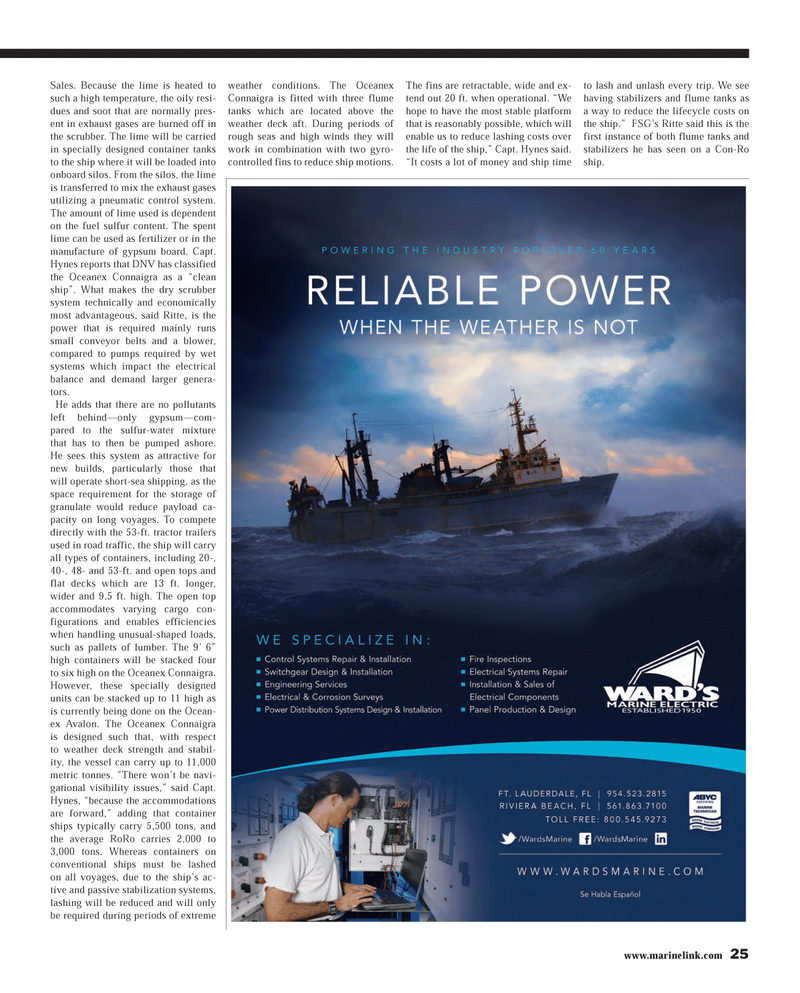
Page 25: of Maritime Reporter Magazine (March 2013)
U.S. Coast Guard Annual
Read this page in Pdf, Flash or Html5 edition of March 2013 Maritime Reporter Magazine
www.marinelink.com 25Sales. Because the lime is heated to such a high temperature, the oily resi-dues and soot that are normally pres-ent in exhaust gases are burned off in the scrubber. The lime will be carried in specially designed container tanks to the ship where it will be loaded into onboard silos. From the silos, the lime is transferred to mix the exhaust gases utilizing a pneumatic control system. The amount of lime used is dependent on the fuel sulfur content. The spent lime can be used as fertilizer or in the manufacture of gypsum board. Capt. Hynes reports that DNV has classified the Oceanex Connaigra as a ?clean ship?. What makes the dry scrubber system technically and economically most advantageous, said Ritte, is the power that is required mainly runs small conveyor belts and a blower, compared to pumps required by wet systems which impact the electrical balance and demand larger genera- tors. He adds that there are no pollutants left behind?only gypsum?com-pared to the sulfur-water mixture that has to then be pumped ashore. He sees this system as attractive for new builds, particularly those that will operate short-sea shipping, as the space requirement for the storage of granulate would reduce payload ca-pacity on long voyages. To compete directly with the 53-ft. tractor trailers used in road traffic, the ship will carry all types of containers, including 20-, 40-, 48- and 53-ft. and open tops and flat decks which are 13 ft. longer, wider and 9.5 ft. high. The open top accommodates varying cargo con- figurations and enables efficiencies when handling unusual-shaped loads, such as pallets of lumber. The 9? 6? high containers will be stacked four to six high on the Oceanex Connaigra. However, these specially designed units can be stacked up to 11 high as is currently being done on the Ocean-ex Avalon. The Oceanex Connaigra is designed such that, with respect to weather deck strength and stabil-ity, the vessel can carry up to 11,000 metric tonnes. ?There won?t be navi- gational visibility issues,? said Capt. Hynes, ?because the accommodations are forward,? adding that container ships typically carry 5,500 tons, and the average RoRo carries 2,000 to 3,000 tons. Whereas containers on conventional ships must be lashed on all voyages, due to the ship?s ac- tive and passive stabilization systems, lashing will be reduced and will only be required during periods of extreme weather conditions. The Oceanex Connaigra is fitted with three flume tanks which are located above the weather deck aft. During periods of rough seas and high winds they will work in combination with two gyro-controlled fins to reduce ship motions. The fins are retractable, wide and ex-tend out 20 ft. when operational. ?We hope to have the most stable platform that is reasonably possible, which will enable us to reduce lashing costs over the life of the ship,? Capt. Hynes said. ?It costs a lot of money and ship time to lash and unlash every trip. We see having stabilizers and flume tanks as a way to reduce the lifecycle costs on the ship.? FSG?s Ritte said this is the first instance of both flume tanks and stabilizers he has seen on a Con-Ro ship.MR #3 (18-25).indd 25MR #3 (18-25).indd 252/26/2013 3:59:33 PM2/26/2013 3:59:33 PM

 24
24

 26
26
